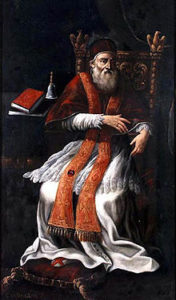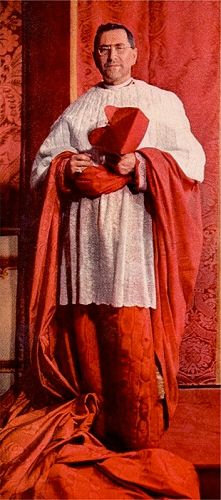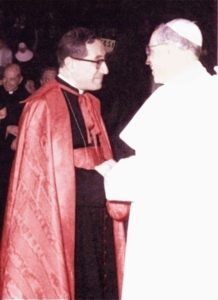
About Article VI of Papal Bull “CUM EX APOSTOLATUS OFFICIO” *
An answer to a question of a reader:
Question:
“I think I have a bad understanding of the “Cum Ex Apostolatus Officio” Bull by Paul IV and I just like to get a correct interpretation, so maybe can you explain in details this to me?
“At the beginning it seemed to be clear to me, but now I can’t find anything about the nullity of orders received by an heretic, unless he is publicly under censorship or hit of irregularity”.
Answer:
Well, let’s look at Article VI of the mentioned Papal Bull.
By Article 6 of “CUM EX APOSTOLATUS OFFICIO”
Pope Paul IV teaches about the invalidity of the heretical “sacrament of consecration”.
“6. Adding that if at any time it will be found that some bishop, even conducting himself as an archbishop or patriarch or already mentioned cardinal of the Roman Church, even, as shown, a legate, or even a Roman Pontiff, before his promotion or assumption as cardinal or as Roman Pontiff had deviated from the Catholic Faith or fallen into some heresy, before his promotion or assumption as Cardinal or as Roman Pontiff, that promotion or assumption concerning him, even if made in concord and from the unanimous assent of all the cardinals, is null, void and worthless; not by the reception of consecration, not by the ensuing possession of the office and administration, or as if, either the enthronement or homage of the Roman Pontiff, or the obedience given to him by all, and the length of whatever time in the future, can be said to have recovered power or to be able to recover power, nor can (the assumption or promotion) be considered as legitimate in any part of it, and for those who are promoted as bishops or archbishops or patriarchs or assumed as primates, or as cardinals or even as Roman Pontiff, no faculty of administration in spiritual or temporal matters may be thought to have been attributed or to attribute, but may all things and each thing in any way said, done, effected and administered and then followed up in any way through them lack power and they are not able to attribute any further power nor right to anyone; and they themselves who are thus promoted and assumed by that very fact, without any further declaration to be made, are deprived of every dignity, place, honor, title, authority, function and power; and yet it is permitted to all and each so promoted and assumed, if they have not deviated from the Faith before nor have been heretics, nor have incurred or excited or committed schism”. (Papal Bull CUM EX APOSTOLATUS OFFICIO Promulgated February 15, 1559 by POPE PAUL IV, 23 May 1555 – 18 August 59)
The Bull, promulgated by Pope Paul IV, followed Pope Leo X’s Bull of Excommunication of Martin Luther and his followers (DECET ROMANUM PONTIFICEM, January 3, 1521), when Luther’s heresy caused the incredibly, terrible disaster in the Catholic Church in Germany and throughout Europe. Furious followers of the fallen Luther seized and occupied thousands of churches and monasteries. More than ten million souls fell into Lutheran heresy and nearly 50,000 people were killed, during the so-called Peasant war in Germany that was provoked by Luther.
Through Luther’s preaching, divorces and impure cohabitation began to be a “norm” for Germans. This destructive process increased and many former Catholic clergy became secret heretics. They appeared to be outwardly Catholic and continued to occupy Cathedrals and village parishes, however, they used their church pulpits for spreading Lutheran heresy in such a way that they continued to destroy and to devastate the Catholic Church.
So, in order to stop this catastrophic process of the destruction caused by the invasion of Lutheran heretics, and thus to save millions of souls, Pope Paul IV issued the Bull “Cum Ex Apostolatus Officio”.
Catholic teaching on the validity of Sacraments is that each Sacrament that is doubtful cannot be taken as valid, and thus it should to be repeated conditionally or absolutely. Sometimes the Sacrament of Matrimony and Orders cannot be repeated in cases where there are specific prohibitive and diriment impediments that exist, which cannot be dispensed.
Every “sacrament”, administered by a heretic can be doubtful. This can take place by any or all of the following ways 1) Intention, 2) Form, 3) Matter, and can be doubtful from the side of a minister and/or to the side of a recipient.
It is commonly known that Luther essentially changed teaching about Sacraments and particularly his heretical conception of “priesthood” was that every man is a “priest”. Such “common priesthood” nullified the sacrament for him and his followers, therefore, the Catholic Church recognizes Lutheran “orders” to be totally invalid.
Of course the Pope did what was right, when he issued the Bull “CUM EX APOSTOLATUS OFFICIO”.
There are two essential details in it:
“is null, void and worthless; not by the reception of consecration”
“without any further declaration to be made”
The same principle, which the Catholic Church applied to Lutheran “priesthood”, is still working towards the “priesthood” of Vatican II today “without any further declaration to be made”, because Vatican II has the conception of “priesthood” that is an exact copy of Luther’s conception of it.
One more word can be said about the Papal Bull “CUM EX APOSTOLATUS OFFICIO”; it is infallible teaching that does not need any further approval. Everyone can see it in Article IX and Article X:
“9. Moreover, in order that the present letter be read to the knowledge of all those whom it concerns, We desire that it or a copy (to which, written underneath with the hand of the public notary and furnished with the seal of some person constituted in ecclesiastical dignity, We determine that full faith is to be shown thereto) be published and posted on the doors of the basilica of the Prince of the Apostles and of the Apostolic Chancery and on the edge of the Campo Flora by some of our runners and that a posted copy of it be left, and that the publication, posting and the notification of the posted copy in this manner suffice and be held as solemn and lawful, nor that another publication be obliged to be required or respected.
10. Therefore, it is permitted to no one to impair this page of Our approval, renewal, sanction, statute, wills of repeal, of decrees, or to go contrary to it by a rash daring deed. If anyone moreover will have presumed to attempt this, he will incur the wrath of almighty God and of the blessed Apostles Peter and Paul.”
Therefore, This Papal infallible declaration is very simple and clear and does not need any further, “more clear” declaration. Any “consecration” administered by heretics of Vatican II “is null, void”, “without any further declaration to be made”.
Fr. UK
* The CUM EX APOSTOLATUS OFFICIO is still the Pontifical Document of binding force for all baptized persons. Its Legislator, Pope Paul IV and his successors never revoked this Bull. The Code of Canon Law of 1917 did not terminate CUM EX APOSTOLATUS OFFICIO. Although this Papal Document is the Ecclesiastical Law **, it touches Faith. Particularly the Pope stated that it applies to the putative acceptation by heretics of the Sacrament of Holy Orders, after they have been promoted to be bishops and even after their putative enthronement as Roman Pontiff. Article VI specifically speaks about that. The promotion or elevation of the heretical bishops even if it has been uncontested and promoted by the unanimous assent of all the Cardinals, shall be null, void and worthless, It shall not be possible for them to acquire validity through the acceptance of the office, or through consecration etc. – the Pope states.
That means that the Pope did not recognize consecrations of the heretical bishops, who have fallen into heresy before their elevation to any bishopric dignity. If the Pope said that the heretical bishops would try to validate themselves through consecration, it is evident that he did not recognize the previous consecrations of these heretics, who clandestinely supported Luther’s false teaching about “common priesthood”, or at least, the Pope viewed those “consecrations” as very doubtful.
A couple of words about Luther’s false conception of the “universal priesthood of all believers”. In his address to the Nobility of the German Nation (1520), Luther taught: “For whoever comes out of the water of baptism can boast that he is already a consecrated priest, bishop, and pope”. Also in another place he said, “That the pope or bishop anoints, makes tonsures, ordains, consecrates, or dresses differently from the laity, may make a hypocrite or an idolatrous oil-painted icon, but it in no way makes a Christian or spiritual human being. In fact, we are all consecrated priests through Baptism”.
The Church condemned this obviously wrong and heretical teaching. This condemnation was made because throughout the whole history of the Church, the Priesthood as a Sacrament of the New Testament was administered only for men. Only men were ordained priests and consecrated bishops; that is a permanent and unquestionable practice of Catholic Tradition, which Luther attempted to destroy.
By Bull EXSURGE DOMINE, of June 15, 1520, Pope Leo X condemned all the false teachings of Luther and specifically the heretical error by which Luther insisted that even women and children could forgive sins in confession. By Bull DECET ROMANUM PONTIFICEM, of January 3, 1521, Pope Leo X excommunicated Martin Luther and all of his followers.
When many clergy, especially those of highest ranks, as bishops, appeared as crypto-Lutherans, the Church in the person of Pope Paul IV, promulgated the Pontifical Document CUM EX APOSTOLATUS OFFICIO, condemning those clerics, who were secret followers of Luther’s heresy. These heretical clerics not only believed in Luther’s false teaching, they also intended to usurp the office of the Holy See.
Particularly by Article VI the Pope spoke not only about the nullity of the promotion and elevation of heretical bishops, but also about the nullity of their consecrations as priests to begin with. Crypto-Lutherans kept the false heretical Luther’s idea of the “universal priesthood of all believers”, and by that very fact, their previous and eventual consecrations would be considered invalid.
The Church had to react to this new dangerous threat, which was no less of a danger than Luther’s heretical revolt itself. While Luther was a heretic outwardly and acted openly, the crypto-Lutheran clergy were clandestine heretics, and thus they were even more dangerous. The Church has reacted to this threat in the person of Pope Paul IV.
Pope Paul IV promulgated the Document concerning Faith and Discipline against the heretical party of “Spirituali” who were in reality, crypto-Lutherans. Some of these crypto-Lutherans even attempted to be elected to the Roman Pontificate. Between the 30s and 50s of the 16th century, (these were the years of the spreading of the “fruits” of Luther’s revolution), heretical tendencies were being spread in the Roman ecclesiastical world.
The party of “Spirituali” had come into existence, represented by crypto-Lutherans, such as Cardinals Reginald Pole, Gasparo Contarini and Giovanni Morone. The “Spirituali” intended to propose the reconciliation of Lutheranism with the Roman Church. They intended to promulgate the crypto-Lutheran “double justification”, rejected by the Council of Trent in 1547. Step by step they moved closer to the moment when they would be able to preach Lutheran heresy openly, and try to destroy the Catholic Church, specifically by means of the annihilation of the Christian Priesthood.
Why did the Pope avoid mentioning heretics by name and why did he use temperate and cautious sentences in his Bull?
Because the heretics were quite powerful and of high rank, and thus they could provoke chaos and anarchy in the whole Roman Church. So the Pope acted very wisely and prudently both spiritually and intellectually. The Bull CUM EX APOSTOLATUS OFFICIO can be a perfect example of the fulfillment of Our Lord Jesus Christ’s commandment: “Behold, I send you as sheep in the midst of wolves. Be ye therefore wise as serpents and simple as doves” (St. Matthew 10:16).
What could have happened if Pope Paul IV was not able to promulgate CUM EX APOSTOLATUS OFFICIO?
In a word, the destructive “Vatican II” could have started 400 years earlier.
** “Ecclesiastical Law obliges all baptized persons who have attained the use of reason and are seven years of age, and also children under seven years of age when the Church explicitly so rules. Therefore, even the excommunicated as well as heretics and schismatic’s are obliged by the laws of the Church” (Moral Theology).

